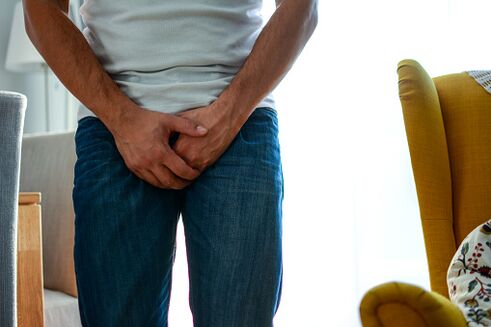It is generally accepted that after 30 years, 30% of men suffer from prostatitis, after 40 - 40%, after 50 - 50%, etc. At the same time, the real morbidity is much higher than the registered one, this is explained by the peculiarities of diagnosis and the possibility of the course of the disease in a latent form.
The prostate gland is a small glandular-muscular organ that is located in the small pelvis under the bladder, covering the initial section of the urethra (urethra). The prostate gland produces a secret that, mixing with the seminal fluid, maintains the activity of sperm and their resistance to various adverse conditions.
With prostatitis, there are numerous problems with urination, decreased libido and impaired erectile function. The saddest thing is that in the absence of proper treatment, about 40% of patients face some form of infertility, since the prostate gland can no longer produce a sufficient amount of high-quality secretion to ensure sperm motility. It is important to remember that similar symptoms can occur not only with prostatitis, but also with prostate adenoma and cancer.
Causes of prostatitis
There are 4 main forms of prostatitis: acute bacterial prostatitis, chronic bacterial prostatitis, non-bacterial prostatitis and prostatodynia.
In persons under 35 years of age, the disease usually occurs in the form of acute bacterial prostatitis. Bacterial prostatitis is called when there is laboratory confirmation of the presence of an infection. Most often it turns out to be chlamydia, trichomoniasis, gardnerellosis or gonorrhea. The infection enters the prostate gland from the urethra, bladder, rectum, through the blood and lymphatic vessels of the pelvis.
However, recent studies prove that in most cases the infection is superimposed on the already existing disorders of the structure of the prostate tissue and blood circulation in it. In non-bacterial prostatitis, bacteria cannot be isolated, although this does not exclude their presence.
In older patients, chronic forms of the disease are more often diagnosed. Prostatodynia is the presence of a clinical picture of prostatitis, compaction of the prostate tissue without signs of inflammation.
Symptoms of prostatitis
The symptoms of prostatitis can be divided into 3 groups:

- disorders of the urinary system (frequent and painful urge to urinate, a feeling of incomplete emptying of the bladder), pain in the lower abdomen;
- disorders of sexual function (soreness along the urethra and in the rectum during ejaculation, weak erection, premature ejaculation, loss of orgasm, etc. );
- increased anxiety and nervousness of a man, due to the fixation of the attention of patients on their condition.
Acute prostatitisusually begins with an increase in body temperature to 39-40 ° C with fever and chills. Difficulty and painful urination. Edema of the prostate gland develops, which can cause acute urinary retention.
Chronic prostatitisproceeds more calmly, but at any time with unfavorable factors an exacerbation may occur. Possibly asymptomatic.
Complications
In the absence of timely therapy, prostatitis can cause the following complications:
- transition of acute to chronic prostatitis;
- obstruction of the bladder with acute urinary retention, which requires surgical treatment, the development of male infertility;
- narrowing and scarring of the urethra;
- recurrent cystitis;
- pyelonephritis and other kidney damage;
- abscess (suppuration) of the prostate, which requires surgery;
- sepsis is a life-threatening complication that often develops in people with reduced immunity (patients with diabetes mellitus, renal failure).
What can you do
If you find yourself experiencing the symptoms described above, try to see a urologist as soon as possible.
What a doctor can do
The modern arsenal of diagnostics of prostate diseases is very wide.
Your doctor will order a bacteriological study of urine and prostate secretions. To clarify the localization of urinary tract infection, a study of different portions of urine is carried out. In addition, a mandatory diagnostic method is a digital examination of the prostate gland. This procedure is not very pleasant, but it is very informative.
Your doctor may refer you for ultrasound examinations of the prostate and pelvic organs. If necessary, prescribe a computed or magnetic-nuclear tomography, cystoscopy, urography and a study of prostate enzymes.
When making a diagnosis, your doctor must rule out the presence of benign prostatic hyperplasia and prostate cancer. For rapid relief of pain in acute prostatitis, analgesics and warm baths may be recommended.
Bacterial prostatitisrequires the appointment of antibiotics, the selection of which is carried out according to the results of bacteriological sowing of secretions on nutrient media and determination of the sensitivity of the pathogen to chemotherapy.
Nonbacterial prostatitisis treated with anti-inflammatory drugs.
Prevention of prostatitis
Do not allow hypothermia of the body, do not sit on cold objects. Follow a light diet (excluding alcohol, spicy, fried and canned foods).
Regular sex life is also a way to prevent prostatitis (since one of the provoking factors is sperm stagnation and frequent erections without subsequent ejaculation). Prevention of sexually transmitted diseases is equally important.
In adulthood, every man should undergo regular (once a year) examinations by a urologist. After suffering prostatitis, preventive outpatient treatment courses are carried out at least 2 times a year for a month and one course of spa treatment.
























